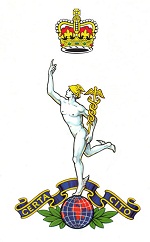Royal Engineers Signal Service
| Royal Signals | |
|---|---|

Cap Badge of the Royal Corps of Signals
|
|
| Active | 1920 – present |
| Allegiance |
|
| Branch |
|
| Part of | Commander Land Forces |
| Garrison/HQ | Blandford Camp, Dorset |
| Motto(s) |
Certa Cito (Swift and Sure) |
| March | Begone Dull Care (Quick); HRH The Princess Royal (Slow) |
| Commanders | |
| Colonel-in-Chief | HRH The Princess Royal |
| Insignia | |
| Tactical Recognition Flash | |
The Royal Corps of Signals (often simply known as the Royal Signals - abbreviated to R SIGNALS) is one of the combat support arms of the British Army. Signals units are among the first into action, providing the battlefield communications and information systems essential to all operations. Colloquially referred to by some as "Siggies", Royal Signals units provide the full telecommunications infrastructure for the Army wherever they operate in the world. The Corps has its own engineers, logistics experts and systems operators to run radio and area networks in the field. It is responsible for installing, maintaining and operating all types of telecommunications equipment and information systems, providing command support to commanders and their headquarters, and conducting electronic warfare against enemy communications.
In 1870, 'C' Telegraph Troop, Royal Engineers, was founded under Captain Montague Lambert. The Troop was the first formal professional body of signallers in the British Army and its duty was to provide communications for a field army by means of visual signalling, mounted orderlies and telegraph. By 1871, 'C' Troop had expanded in size from 2 officers and 133 other ranks to 5 officers and 245 other ranks. In 1879, 'C' Troop first saw action during the Anglo-Zulu War. On 1 May 1884, 'C' Troop was amalgamated with the 22nd and 34th Companies, Royal Engineers, to form the Telegraph Battalion Royal Engineers; 'C' Troop formed the 1st Division (Field Force, based at Aldershot) while the two Royal Engineers companies formed the 2nd Division (Postal and Telegraph, based in London). Signalling was the responsibility of the Telegraph Battalion until 1908, when the Royal Engineers Signal Service was formed. As such it provided communications during the First World War. It was about this time that motorcycle despatch riders and wireless sets were introduced into service.
...
Wikipedia
